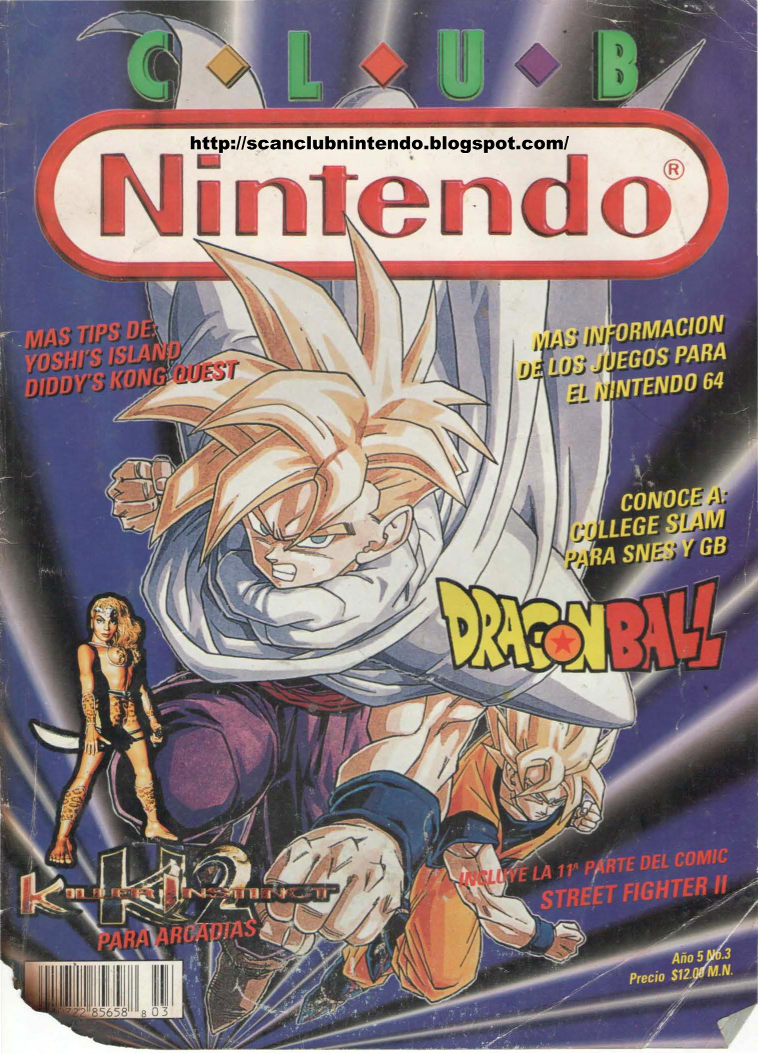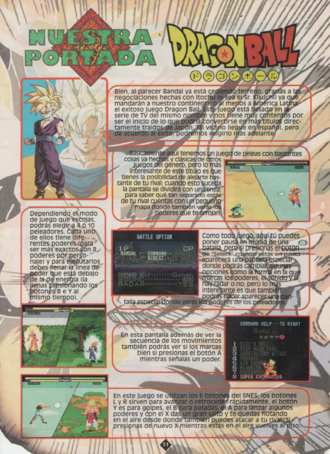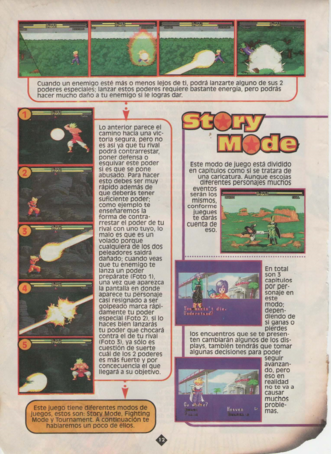Dragon Ball Z: Super Butouden 2 (lost English localization of Super Nintendo fighting game; 1996): Difference between revisions
No edit summary |
m (Added content and references.) |
||
| (14 intermediate revisions by 8 users not shown) | |||
| Line 1: | Line 1: | ||
{{InfoboxLost | {{InfoboxLost | ||
|title=<center>Dragon Ball (SNES)</center> | |title=<center>Dragon Ball Z: Super Butouden 2 (SNES)</center> | ||
|image=01fit.png | |image=01fit.png | ||
|imagecaption=Cover to Club Nintendo (Mexico) Year 5, Issue 3 (Date: March | |imagecaption=Cover to Club Nintendo (Mexico) Year 5, Issue 3 (Date: March 1996) | ||
|status=<span style="color:red;">''' | |status=<span style="color:red;">'''Lost'''</span> | ||
}} | }} | ||
'''''Dragon Ball Z: Super Butōden 2''''' is a 1993 fighting game for the Super Nintendo Entertainment System. It is the sequel to Dragon Ball Z: Super Butōden and features one-on-one fights using a six-button configuration. The game follows the Cell Games arc and includes characters from the films Dragon Ball Z: Broly – The Legendary Super Saiyan and Dragon Ball Z: Bojack Unbound. | |||
==History== | |||
In 1995, Funimation produced an American dub of the original ''Dragon Ball'' anime in hopes of capitalizing on the success of the series as it had in the rest of the world. It was done for 13 episodes, and after a year they dropped ''Dragon Ball'' and decided to dub ''Dragon Ball Z''. | |||
But somewhere in between this transition, there was going to be a '''fully English-localized version of ''Dragon Ball Z: Super Butouden 2''''' for the Super Nintendo Entertainment System released around the time ''Dragon Ball Z'' started. | |||
Little information has appeared, other than a cover story in the Mexican Edition of Club Nintendo, dated March 1996 (Year 5, issue 3). Some of the changes included calling Brolly "Tara" and Mr. Satan "Saron".<ref>"Nuestra Portada - Dragon Ball". Club Nintendo (in Spanish). Vol. 5, no. 3. Editorial Televisa [es]. March 1996. pp. 11–14.</ref> | |||
Other than that, no other information about the localization has appeared. | |||
Though the English localization was not released, the game first made its Western release in June 1994 in Europe, localized in French under the name of ''Dragon Ball Z: La Légende Saien''.<ref>https://archive.org/stream/Nintendo_Accion_015#page/n13/mode/2up</ref><ref>https://archive.org/stream/HobbyConsolas030#page/n39/mode/2up</ref><ref>https://archive.org/stream/Nintendo_Accion_018#page/n28/mode/2up</ref><ref>https://www.jeuxvideo.com/articles/0001/00013532-dragon-ball-z-2-la-legende-saien-test.htm</ref> | |||
''Super Butouten 2'' would later have another official western release through a preorder bonus for ''Dragon Ball Z: Extreme Butouden'' in the United Kingdom and the United States. However, this was the Japanese version rather than the unreleased English version. | |||
==Gallery== | ==Gallery== | ||
<gallery mode=packed heights=303px> | |||
File:14fix.png|Page 1 of the cover story | |||
File:15fix.png|Page 2 of the Cover Story | |||
</gallery> | |||
==References== | |||
{{reflist}} | |||
==External Links== | |||
*https://en.wikipedia.org/wiki/Dragon_Ball_Z:_Super_But%C5%8Dden_2 | |||
* [http://dragonball.wikia.com/wiki/Dragon_Ball_Z:_Super_But%C5%8Dden_2 ''Dragon Ball Wiki Page''] | |||
[[Category:Lost video games]] | [[Category:Lost video games]] | ||
[[Category:Completely lost media]] | |||
Latest revision as of 04:55, 21 February 2024
Dragon Ball Z: Super Butōden 2 is a 1993 fighting game for the Super Nintendo Entertainment System. It is the sequel to Dragon Ball Z: Super Butōden and features one-on-one fights using a six-button configuration. The game follows the Cell Games arc and includes characters from the films Dragon Ball Z: Broly – The Legendary Super Saiyan and Dragon Ball Z: Bojack Unbound.
History
In 1995, Funimation produced an American dub of the original Dragon Ball anime in hopes of capitalizing on the success of the series as it had in the rest of the world. It was done for 13 episodes, and after a year they dropped Dragon Ball and decided to dub Dragon Ball Z.
But somewhere in between this transition, there was going to be a fully English-localized version of Dragon Ball Z: Super Butouden 2 for the Super Nintendo Entertainment System released around the time Dragon Ball Z started.
Little information has appeared, other than a cover story in the Mexican Edition of Club Nintendo, dated March 1996 (Year 5, issue 3). Some of the changes included calling Brolly "Tara" and Mr. Satan "Saron".[1]
Other than that, no other information about the localization has appeared.
Though the English localization was not released, the game first made its Western release in June 1994 in Europe, localized in French under the name of Dragon Ball Z: La Légende Saien.[2][3][4][5]
Super Butouten 2 would later have another official western release through a preorder bonus for Dragon Ball Z: Extreme Butouden in the United Kingdom and the United States. However, this was the Japanese version rather than the unreleased English version.
Gallery
References
- ↑ "Nuestra Portada - Dragon Ball". Club Nintendo (in Spanish). Vol. 5, no. 3. Editorial Televisa [es]. March 1996. pp. 11–14.
- ↑ https://archive.org/stream/Nintendo_Accion_015#page/n13/mode/2up
- ↑ https://archive.org/stream/HobbyConsolas030#page/n39/mode/2up
- ↑ https://archive.org/stream/Nintendo_Accion_018#page/n28/mode/2up
- ↑ https://www.jeuxvideo.com/articles/0001/00013532-dragon-ball-z-2-la-legende-saien-test.htm


